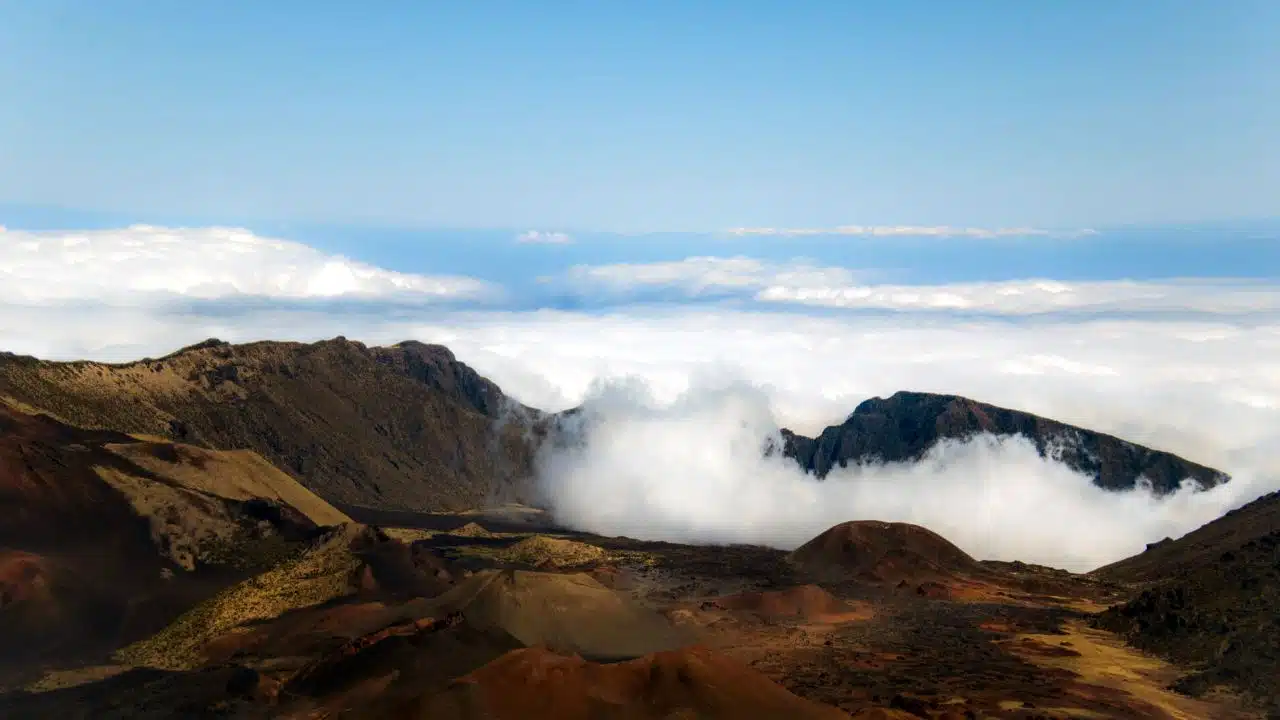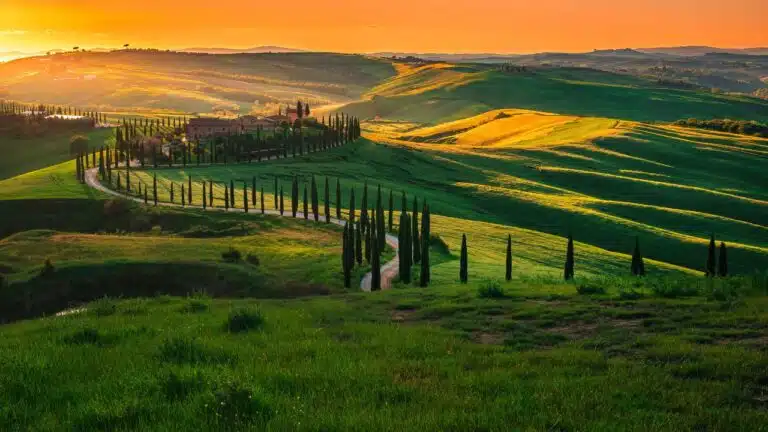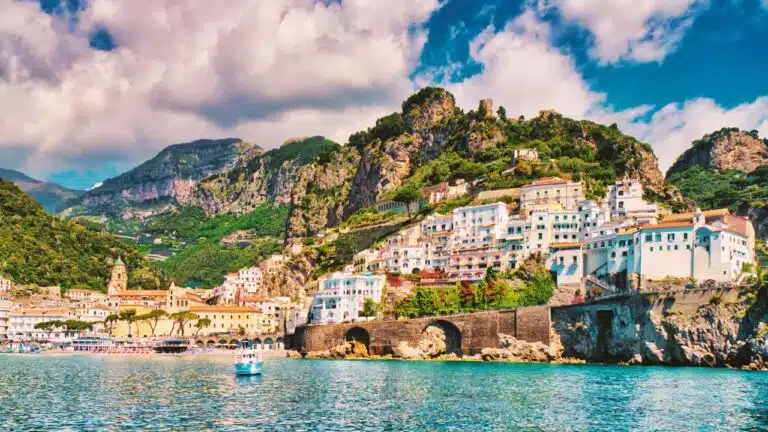The Hawaiian Islands may seem simple on the surface—a land of beautiful beaches, lush jungles, and romanticism—but make no mistake, Hawaii was forged in fire. Formed by a volcanic hot spot, the islands reveal a trail of volcanic eruptions stretching from the oldest island in the northwest, Kauai, to the youngest in the southeast, the Big Island. And while some have been extinct for centuries, others continue to spew fire and spill lava flows into the sea. So just where can you find these marvels of nature? From the heart of the Hawaii Volcanoes National Park to the shores of Waikiki, we’ll take you on a star-studded journey of the best volcanoes in Hawaii.
Table of Contents
- Which Hawaiian Island Has the Best Volcano?
- What Is the Most Visited Volcano in Hawaii?
- The 10 Best Volcanoes in Hawaii?
- Pro Tips for Visiting Hawaii’s Active Volcanoes
- Next Vacay Can Take You to the Best Volcanoes in Hawaii
Which Hawaiian Island Has the Best Volcano?
Hawaii’s Big Island is known for having two of the most active volcanoes in the US: Kilauea, the youngest, and Mauna Loa, the largest. Kilauea’s near-continuous eruptive activity makes it the most active volcano in the world and one of Hawaii’s most popular tourist attractions.
What Is the Most Visited Volcano in Hawaii?
Over 1.2 million people visited Hawaii Volcanoes National Park in 2021. The majority of those visitors scaled to the summit of Kilauea in hopes of witnessing an active eruption. Hawaii’s other most active volcano, Mauna Loa, also sits inside Hawaii Volcanoes National Park but sees far fewer visitors.
The 10 Best Volcanoes in Hawaii
While no longer all active, Hawaii’s volcanoes provide a glimpse into the islands’ pasts and futures. Bringers of new land and harbingers of destruction, here’s your guide to the ten best volcanoes in Hawaii.
1. Kilauea
Visitors wanting to see lava flow in action have their best chance at the Kilauea volcano, located in the Hawaii Volcanoes National Park on the Big Island. Thought to be between 210,000 to 280,000 years old, Kilauea is one of the most active volcanoes in the world.
Halema’uma’u crater has been the center of activity in Kilauea for years and is said to be home to the Hawaiian goddess of volcanoes herself, Pele.
As recently as 2018, the Kilauea volcano erupted in a mountain of fire, adding over 850 acres of land to the Big Island and a new black sand beach while destroying over 700 homes. Yet, despite the danger, or perhaps because of it, Kilauea remains the most visited volcano in Hawaii.
Top Things to Do at Kilauea
Kīlauea Iki Crater: Visitors can hike the Kīlauea Iki Crater Trail to walk across a once-bubbling lake of molten lava or journey around the Kilauea summit caldera on the Crater Rim Trail.
Crater Rim Drive: The drive follows Crater Rim Road and highlights Hawaii Volcanoes National Park’s best features, including steam vents, the Kilauea Overlook, and the Thurston Lava Tube, a walk-in lava tube that’s easily accessible from the Kīlauea Iki parking lot.
2. Diamond Head
While Kilauea is the best and most visited of Hawaii’s volcanoes, Diamond Head is arguably the most recognizable. Sitting sentinel at the eastern edge of Waikiki, Diamond Head’s impressive stature dominates the south shore coastline.
The extinct volcano has been dormant for roughly 150,000 years, but that does little to diminish people’s interest. Part of that has to do with the 760-foot summit. The volcano’s peak offers jaw-dropping views of Waikiki and Oahu, making the climb to get there well worth the effort.
Top Things to Do at Diamond Head
Diamond Head Hiking Trail: This historic hiking trail takes visitors through Diamond Head’s fascinating history, steep staircases, and even a pitch-black tunnel to reach the awe-inspiring summit.
Helicopter Tour: Helicopter tours are a popular way of experiencing the Diamond Head volcano, offering a bird’s eye view of the stunning crater.
3. Mauna Kea
Mauna Kea is a dormant volcano on the Big Island and the tallest mountain in Hawaii. When measured from base to tip, it’s taller than even Mount Everest. It’s easy to forget that Hawaii is home to eleven of the world’s thirteen climates, but Mauna Kea is a stark, white-capped reminder. Crowned by snow, even sometimes in the summer, it’s one of the few places you can drive from a tropical beach at sea level to a staggering 14,000 feet in a few short hours.
In ancient times, it was forbidden for all but kings and priests to journey to the summit, which was home to the snow goddess Poli‘ahu and a sacred realm of the gods. Now, the volcano’s summit hosts one of the world’s largest observatories studying the stars and black holes.
Top Things to Do at Mauna Kea
Humu’ula Trail: This 12-mile trail will take you to the summit of Mauna Kea and back. The steep incline is a challenge, but the views are especially sweet, from cinder cones to stunning Mauna Loa and even the other Hawaiian Islands in the far-off distance.
Lake Waiau Trail: The Lake Waiau Trail is under two miles, much shorter than the hike to Mauna Kea’s summit. The sacred lake is an oddity among scientists because it exists at such a high altitude. Nevertheless, it’s a breathtaking sight, and that’s only partly because of the elevation!
Mauna Kea Stargazing Program: There’s a reason Mauna Kea’s summit is home to the largest observatory of its kind. The stargazing here is epic. Few other places or volcanoes could offer up the same unpolluted views of the night sky.
4. Mauna Loa
Stretching over ten miles from base to summit and covering half of the Big Island’s landmass, Mauna Loa is the largest active volcano in the world. Considering Mauna Loa means “Long Mountain,” it seems an apt descriptor for this towering behemoth.
And while Kilauea is the current crowned king of active volcanoes, Mauna Loa has its own busy history. Over 30 eruptions have been recorded since 1843, including an eruption in 1984 that came within miles of Hilo, the most densely populated city on the Big Island.
After decades of quiet unease, the sleeping dragon awoke again on November 27th, with Mauna Loa experiencing its first eruption in 38 years. Though eruptions stopped two weeks later, the activity has left scientists with more questions than answers about the reasons behind Mauna Loa’s eruptions.
Top Things to Do at Mauna Loa
Hiking Trails: Not for the faint of heart, the Mauna Loa Observatory and Summit Trails are a challenging but rewarding way to experience Mauna Loa’s fascinating lava formations and beautiful views.
Kaʻū Scenic Byway: This 54-mile byway is the southernmost byway in the United States. Traversing the slopes of Mauna Loa, it offers up a different view of the volcano’s features, with a diverse and ever-changing landscape that even includes recent lava flows.
5. Haleakala
The Haleakala volcano is a restless giant encompassing over seventy-five percent of Maui’s landmass. The island’s only active volcano has had ten eruptions over the past thousand years. While the latest took place some four hundred years ago, that doesn’t mean it won’t erupt again in the future.
Located in Haleakala National Park on the east side of Maui, the name Haleakala immediately inspires visions of breathtaking sunrises. Of course, legend has long said that this “house of the sun” was where the demigod Maui lassoed the star and slowed its passage across the sky. Visiting this national park and one of the best volcanoes in Hawaii is almost a prerequisite for staying on Maui.
Top Things to Do at Haleakala
Haleakala Sunrise: Waking up before sunrise to see it all go down—or up, in this case—from the summit of Haleakala is nothing short of magical. Because viewing the sun from here is so popular, guests to the park now have to make a reservation to see this spectacle in person.
Sliding Sands Trail: The unique landscape along the Sliding Sands Trail may dupe you into thinking you’ve left Hawaii and landed on Mars. Otherworldly sights of beauty await, from lava rock fields to Haleakalā silverswords and sloping red hills marking past eruption sites.
Red Hill (Pu’u‘ula‘ula): The highest point on Haleakala reaches just over 10,000 feet. Here, you’ll be standing above the clouds! This makes it a popular spot for Haleakala sunrises, panoramic views, and stargazing.
6. Hualalai
Hualalai is the third most active volcano on the Big Island. Though it hasn’t erupted in over two hundred years, it has still shaped the island’s landscape. The Kona International Airport is built on top of lava flow from the Hualalai volcano, and Kona Coffee is cultivated, in part, along its slopes. The ash soil from its volcanic cones helps create the Kona Coffee Belt and some of the best conditions in the world for growing coffee.
Top Things to Do at Hualalai
Helicopter Tour: Hualalai’s summit sits pretty at a lofty height of over 8,000 feet. Consequently, a helicopter tour is one of the best ways to get a good look at the summit and the surrounding landscape.
Coffee Plantation Visit: Kona is home to hundreds of coffee farms, many of which offer tours to the public. Visitors can learn how beans are harvested and processed and enjoy a fresh cup of rich Kona coffee.
7. Kohala
The best volcanoes in Hawaii can’t be discussed without mentioning the oldest volcano on the Big Island. Kohala sits on the northern end and is where the Big Island began almost a million years ago. As a result, some of the most diverse landscapes can be found here, including staggering sea cliffs formed from an avalanche that sent large parts of the Kohala volcano tumbling into the sea.
The last time Kohala erupted was roughly 120,000 years ago, which really puts its age into context against the active volcanoes still found on the island of Hawaii. But perhaps the best judge of its age is that it’s old enough to have experienced the last magnetic field reversal 780,000 years ago.
Top Things to Do at Kohala
Kohala Mountain Road: Also known as the “High Road,” Kohala Mountain Road meanders along twenty miles of beautiful scenery, from grassy fields to lofty peaks and lush forests with plenty of scenic lookouts along the way.
Awini Trail: The trail starts at the Pololu Overlook and offers stunning views of the rugged Kohala coast, including the epic sea cliffs and valleys carved into the dormant Kohala Volcano. And at its end lies the eerie and unmatched sight of a remote black sand beach.
8. West Maui Mountains
The West Maui Mountains are where the heavens meet the earth. Or at least where they used to. Millions of years ago, in its prime, the volcano now known as Mauna Kahālāwai towered above the land at roughly 11,000 feet, taller than Haleakala. However, thousands of years have cut the once impressive stature to under 6,000 feet. At the same time, erosion, landslides, and other processes have carved into the remains of this now-extinct shield volcano, turning its landscape into a tapestry of lush valleys, verdant rainforests, and cascading falls.
Top Things to Do at West Maui Mountains
West Maui Circle Drive: Terrifying and exhilarating, this winding drive rivals the Road to Hana in the east. Honoapi’ilani Highway takes you on a loop around the rugged west coast of Maui, unveiling spectacular coastal scenery and some pretty amazing Maui beaches.
Īao Valley State Park: As the second wettest area in Hawaii after Kauai, the Iao Valley bursts with lush greenery and diverse wildlife. One of the most popular features is the short paved walk to the lookout for the Iao Needle, an erosion feature that rises 12,000 feet to pierce the sky like a needle.
9. East Molokai
The East Molokai volcano is an extinct shield volcano covering two-thirds of east Molokai. It’s often called Wailau, after the Wailau Valley cutting through its northern side. Its highest peak, Kamakou, rises just under 5,000 feet tall.
Over a million years ago, the East Molokai mountains were much larger until a catastrophic collapse destroyed much of the northern end of the volcano. What now remains of the once-great north end of East Molokai is perhaps even more stunning: the tallest sea cliffs in the world.
Top Things to Do at East Molokai
Kalaupapa National Historical Park: No trip to one of Hawaii’s best volcanoes would be complete without a stop at this historic park. Visitors get a firsthand look at the island’s storied past as a quarantine location for patients with leprosy and an unparalleled look at the Molokai sea cliffs.
10. Waianae
Home to the highest peak on Oahu, the Waianae Range is all that remains of an ancient shield volcano that last erupted over 2.5 million years ago. While extinct volcanoes like Waianae may be less exciting than the molten lava shows in Hawaii Volcanoes National Park, there’s something to be said for trading fire for earth. Instead of smoke and heat shows, Waianae treats visitors to a captivating landscape of flora and fauna, and for those that reach the summit, a walk through a magical cloud forest.
Top Things to Do at Waianae
Mount Ka‘ala Reserve: Encompassing over 1,000 acres of forest and rugged terrain, unique plants and animals form a diverse ecosystem. Scenic hikes bestow breathtaking views, and at the summit of Mt. Ka‘ala, visitors will find a boardwalk that leads through the enchanting cloud forest.
Pro Tips for Visiting Hawaii’s Active Volcanoes
Visiting some of the best volcanoes in Hawaii means taking some precautions when you go. Active volcanoes are a force of nature, and whether you’re headed to the Hawaii Volcanoes National Park to see Kilauea and Mauna Loa or to the island of Maui to watch the sunrise from Haleakala, it’s essential to prep before you go.
- Follow the rules. It’s unfortunate, but people have died visiting Hawaii’s volcanoes. Ensure your safe trip to some of the best volcanoes in Hawaii by following the park’s rules and listening to park rangers.
- Don’t get too close. Consider this an addendum to the first tip, but don’t—we repeat, don’t—get too close. Safety barriers are there for a reason, and while an epic pic of glowing lava sounds cool, it’s by no means worth your life.
- Wear good shoes. Flip flops will work for Hawaii’s sandy beaches, but the sharp lava rocks demand a sturdy pair of shoes to protect your feet.
- Don’t breathe. Just kidding. You don’t have to stop breathing, but you’ll want to breathe carefully where the lava meets the sea. It forms a toxic mist called laze that can be potentially deadly.
- Dress appropriately. Hawaii has a warm climate, but the high mountain summits can be especially chilly—just look at snow-capped Mauna Kea.
- Reserve your spot. Seeing the view from the top of the summit could require a reservation ahead of time, so make sure to check before you go.
- Bring water and sunscreen. Between hot lava fields, grueling hikes, and unforgiving sun, the heat can be scorching, so don’t forget to pack plenty of water and sun protection.
Next Vacay Can Take You to the Best Volcanoes in Hawaii
Whichever of Hawaii’s volcanoes you want to explore, Next Vacay can make your dreams come true with the perfect flight deal. Fly into Kona and take a scenic drive along Hawaii’s Belt Road to the best volcanoes found on the Hawaiian Islands. Or, head into Oahu to explore the wonder that is Diamond Head. Better yet, fly down to Maui to catch a sunrise unlike any other from the summit of Haleakala.
With amazingly cheap flight deals, you can save hundreds on your trip to Hawaii. So stop worrying about paying for the experience of a lifetime and start worrying about living it with Next Vacay.



